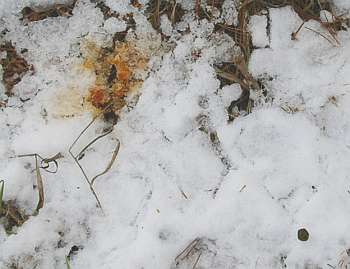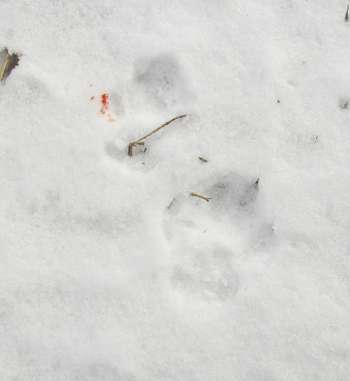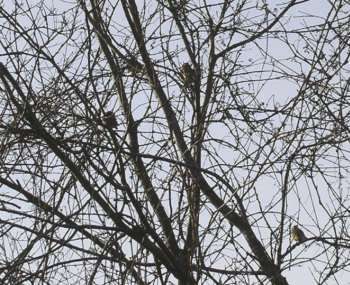
Walking on the trail created by the heavy equipment that comes to take topsoil in the scrape (but hasn't been here since the snow fell), I saw a clue that something was amiss.

Snow not only preserves tracks, it also shows up whatever has gone on. When I saw the blood I first wondered if it was cast-off from a kill. But there was a regular trail, and soon I came upon this:

Somebody had cut a toe on his back foot, I could see small spots of blood in a whole line of tracks. Cut on ice?
There certainly was ice. We've had enormous amounts of rain over the last few weeks, then the cold snap, producing scenes like the one below.

There was a good breeze blowing, making the trees in the ice sway, producing quite an amazing sound of crackling and heaving. A lot of the water had drained away, leaving a gap between its surface and the ice.
And there were birds. Not many--things are pretty quiet this time of year. But there were chickadees, of course. But what was that other sound? I could hear something not quite right. I pished a little, brought in a couple of chickadees and another bird. Yellow-rumped warbler! This warbler is known to hang around well past the time the rest have flown. Fifteen were reported in last week's Prince Edward County and Quinte Area Bird Report, from Prince Edward County. But I've never seen one here this late before. But if you look at this range map, you can see that they are known to winter in New York State, just the other side of Lake Ontario. Maybe the winter range is shifting north, like the ranges of so many species are.
The Cedar Waxwing on the other hand is a common winter bird here. On my way back home I saw a nice flock of 15 or so, bouncing back and forth between two trees.







No comments:
Post a Comment